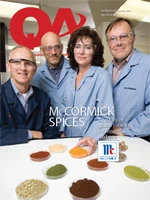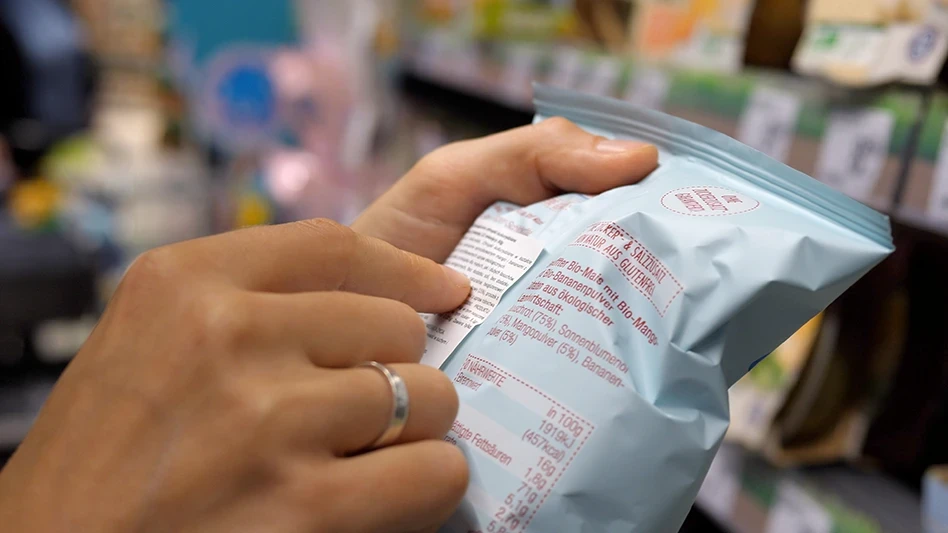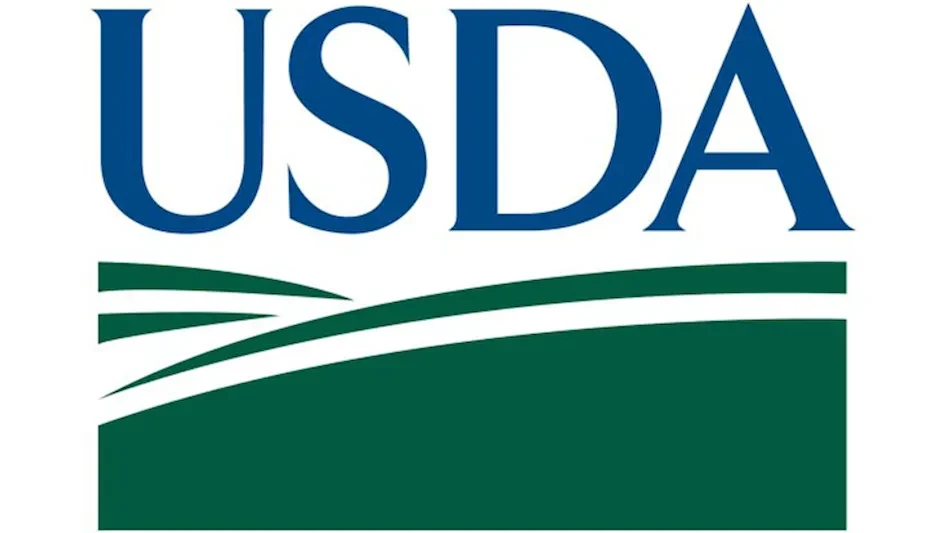Defined as Zone 1, the contact surfaces for ready-to-eat (RTE) foods pose a critical point in plant cleaning and sanitation. Sanitation experts note that it is not so much practices that may differ between zones and food- and nonfood-contact surfaces, rather it is frequency.
"The recommended process is the same for food-contact and non-food-contact surfaces," said Katie Walker, food safety director for QSI, a member of The Vincit Group. "We expect non-food surfaces to be just as clean as food contact surfaces because that’s an indication of how clean the room is. But we do emphasize frequency for food-contact surfaces."
Rob Cook, vice president of Biomist Inc., agreed, noting that since food-contact surfaces are a critical point, they have to be cleaned and sanitized more frequently than other areas.
A key factor in the sanitation of a plant is its adherence to GMPs, added Bill Race, senior vice president of AFCO, who also believes that sanitizing should be just as strong in further processing areas as in RTE. While always of note, "GMPs are becoming more important and a lot of processors are becoming more focused on monitoring of GMPs," he said, adding that sanitation can be traced directly back to GMPs.
One example Race gave was that of the increasing practice of cleaning and sanitizing of the entire RTE area on a daily basis—including walls. "We didn’t used to see that," he said, noting that much of the increased practice is driven by major retailers who are setting higher standards and expecting them of their suppliers.
Training. Vital to attaining and maintaining these standards, each of the experts noted, is training of plant personnel and monitoring for compliance.
A common question Race gets from food plants is how to ensure that employees are washing their hands and not walking over the foot bath when returning from breaks. A few solutions Race has seen in plants are products that count the number of employee hands being washed, putting a person in place purely to monitor employee handwashing, and rubber boots supplied for restricted areas. "It’s very difficult to monitor employees," Race said, "but the more procedures you have like that, the more you can be assured the GMPs are being followed."
"My key recommendation is training to make sure all sanitarians are up to speed in cleaning and sanitizing procedures for equipment or areas," Cook said. "Hand hygiene is critical, and decontaminating tools, equipment and the environment helps prevent cross-contamination. Hands or gloves touch an unclean surface, then touch a food product and you have a contaminated item.
"The cleaner the environment, the better," he said. "Focus on the sanitation process with the quality assurance professional focusing on continuous improvement, training, retraining, sanitation procedures and design of equipment."
Equipment design is, in fact, a key component in ensuring sanitation. A great deal of plant equipment does not comply with 3-A Sanitary Standards, Cook said, and is difficult to clean with cracks and crevices where microbes can lodge. "Once microbes get a foothold, they create a biofilm—a coating to protect themselves."
It is especially critical in RTE areas that equipment is frequently rotated and dismantled for deep cleaning, Walker said. In addition, RTE equipment should be assessed for sanitary design. Is it made of cleanable materials? Are all parts accessible for cleaning? Does it have minute cracks or large holes, rough or sloppy welds?
A Hurdle Approach. To ensure the cleanest environment and food safety, Cook recommends the use of a hurdle approach with multiple interventions. "What one process doesn’t kill, another will. There are more hurdles for the bacteria to overcome."
It is just such an approach that Walker recommends for wet cleaning of RTE and further processing areas alike. The eight-step cleaning and sanitizing process includes:
- Dry pick up. Physical removal of as much visible soil as possible.
- First rinse. Proportionately the longest step, it is one of the most critical in removal of visible soils. In fact, Walker said, "The room should visibly look clean at the end of the first rinse."
- Foam detergent application. A foam detergent should be applied daily from bottom upward to equipment, structure and walls. Generally walls should be foamed to eight feet, going higher as needed. The application should have a shaving-cream-like consistency, but be thin enough to adhere to vertical surfaces. Contact dwell time should be about 10-15 minutes.
- Hand scrub, with particular emphasis on food-contact surfaces. "It is really hard to penetrate biofilm with chemicals alone, so routine scrubbing is critical," Walker said. The scrubbing helps to both remove existing biofilm and prevent its development. Because biofilm acts as a protective outer layer for dangerous bacteria, it is not always detected by a swab test. However, during production the vibration of equipment and resulting friction can cause biofilm layers to shed, allowing dangerous bacteria to leech out from beneath the protective coating and contaminate food. "Because of the nature of biofilms, just because bacteria may not have been found at pre-op doesn’t mean it wasn’t there," she said. "That’s why scrubbing is so critical."
- Second rinse. The step requires application from top down, so that rinse water does not contaminate already rinsed surfaces.
- Sanitation self inspection. "This is where you stop hosing and use a flashlight and look, touch and smell—looking for visible soil, touching and feeling for residue, and smelling for odors," Walker said. Inspect chains, boxes, drains … "follow your nose." Mimic the style of QA and regulatory inspectors, she said, adding, "Mimic them but then get to know the equipment better than them. A well-trained QA or sanitation employee should know the equipment better than anyone."
- Wipe overheads. Keeping overheads dry, clean and clear of beaded water and condensation is a requirement of any pre-op SSOP and regulation.
- Sanitize. Sanitizer should be applied from the bottom up and full coverage is key, Walker said, adding, "I want to see moving equipment moving during the first rinse, the initial foam application, the second rinse and the sanitizer application. That ensures full coverage and allows application inside moving parts, belts and chains." But even with this, Walker said, the sanitizing step should be viewed as only an insurance step. The real focus should be on the cleaning steps.
The eight steps should be conducted daily in RTE areas, with at least four hours allowed for the process.
Once the process is complete, it is important to ensure that the environment is completely dry before and during production. "A rule of thumb in RTE is the dryer the environment is maintained, the better," Walker said. "If you are doing mid-shift rinses, you could be introducing an additional water source for bacteria or spreading microbes."
And in some plants, it is critical to maintain a dry environment at all times. In those plants cleaning focuses on dry wiping, vacuuming, then sanitation. "It depends on the industry and type of product," Cook said. He has seen plants steering away from water as much as possible, as water can promote microbial growth.
In other plants with extended runs, it can be challenging to maintain increased production while maintaining a safe environment that is bacteria free. "I see breweries that never stop; they clean on the fly," Race said, adding that in such cases, "you have to scientifically prove that you can go longer and stay microbe-free."
A Clean Environment. How many samples should be taken to determine if any pathogens, such as Listeria, remain in the environment?
"You need to start by knowing where it’s not," Walker said. "Some plants pull hundreds of samples to really pull it out." A best practice in sampling is to literally map out your samples then color code the areas as to results. "It’s interesting what can pop out when it’s presented visibly like that."
In any case, ensuring a clean environment is a combination of cleaning, sanitizing and testing. "The key," Walker said, "is to anticipate the situation and aggressively clean and sanitize while aggressively pulling plate swabs."
The author is Managing Editor of QA magazine. She can be reached at llupo@giemedia.com.
*****
Cleaning & Sanitation
Manufacturers Guide
Biomist www.biomistinc.com | 847-850-5530
Biomist is a safe method for applying concentrated alcohol as a sanitizing agent. Simply point and spray; the penetrating mist reaches into small cracks and crevices to kill pathogens where they hide. Ideal for heat- or water-sensitive equipment and facilities, Biomist’s D2-rated formula sanitizes in seconds and quickly evaporates to leave surfaces and equipment dry and ready for use. In addition, Biomist is non-corrosive and safe for use on food-contact surfaces, computers, electronics and precision equipment. Biomist can be used as an intervention technique for RTE areas and pre-operational/in-shift sanitizing of processing and packaging equipment.
*****
BioSafe Systems www.biosafesystems.com | 888-273-3088
SaniDate 5.0 Sanitizer/Disinfectant from BioSafe Systems controls disease in processing waters and on equipment and hard surfaces. Its activated peroxygen formula is EPA registered for a broad range of diseases including plant spoilage organisms and human health pathogens such as E. coli, Listeria, and Salmonella. SaniDate 5.0 kills disease in 60 seconds and is ideal for sanitizing packinghouses, beverage, dairy, meat and produce processing facilities. Also approved for use in clean-in-place systems, SaniDate 5.0 eliminates disease bacteria from process lines. Its reduced-risk, environmentally friendly formula is an effective alternative to chlorine, quat and phenol compounds, meets the requirements of the National Organic Program and is OMRI listed.
*****
Hill Brush Inc. www.hillbrush.com | 800-998-1515
Hill Brush has been manufacturing a comprehensive premier line of quality, innovative, manual cleaning tools since 1922. Under the Salmon Hygiene Technology brand, the specialized line is specifically designed to clean hygienically sensitive areas in food production facilities and other establishments. Designed for ease of cleaning, the ergonomics of the product have a positive effect on the person using it, leading to prolonged energy and usage. Available in eight colors to help prevent cross-contamination, the line includes tools for problem areas; withstands temperatures up to 273oF; has high durability and promotes environmental safety.
*****
Perfex Corporation www.perfexonline.com | 800-848-8483
Perfex Lite-N-Tite 100% Synthetic Upright Brooms have color-coded poly fibers angled for uniform surface contact. Polypropylene fibers are fused onto high-impact-resistant polymer blocks, eliminating premature fiber fallout and areas for contaminants to collect. Color-coded brooms and brushes are easily identified and can be prevented from use in unassigned areas; reducing the risk of cross-contamination. The brooms are available in red, white, blue, green and yellow; color ompatible polymer handles are also available.
*****
Sterilex Corporation www.sterilex.com | 800-511-1659
Recommended by top food safety experts, Sterilex’s patented PerQuat technology is EPA-approved for biofilm removal for both public health and industrial applications. A hybrid disinfectant/cleaner, PerQuat technology can be used in a variety of food processing sanitation applications including environmental and food-contact foaming, as a tank soak for belts and equipment parts, or for use as part of Sterilex’s drain sanitation program. When added to a comprehensive plant sanitation program, Sterilex chemistry has proven to eliminate spikes in counts and increase shelf life while eliminating the need for hand scrubbing.

Explore the June 2010 Issue
Check out more from this issue and find your next story to read.
Latest from Quality Assurance & Food Safety
- FSIS to Host Virtual Public Meetings on Salmonella Framework
- Climate-Smart Soybeans Enter U.S. Market
- Yoran Imaging Introduces Thermal Imaging-Enabled System for Induction Seal Inspection and Analysis
- GDT Highlights Food Safety Solutions for Food Processing and Packaging Facilities
- FSIS Issues Public Health Alert for Ineligible Beef Tallow Products Imported from Mexico
- Wolverine Packing Co. Recalls Ground Beef Products Due to Possible E. Coli Contamination
- McDonald’s USA, Syngenta and Lopez Foods Collaborate to Help Produce Beef More Sustainably
- Divert and PG&E Announce Interconnection in California to Address Wasted Food Crisis





